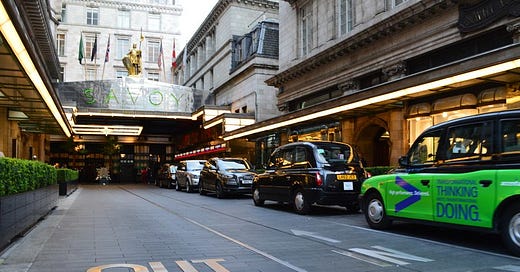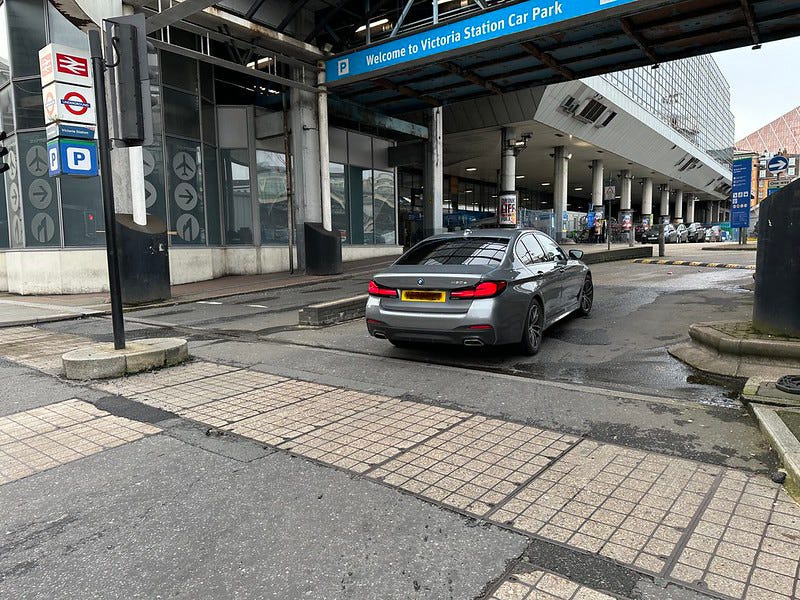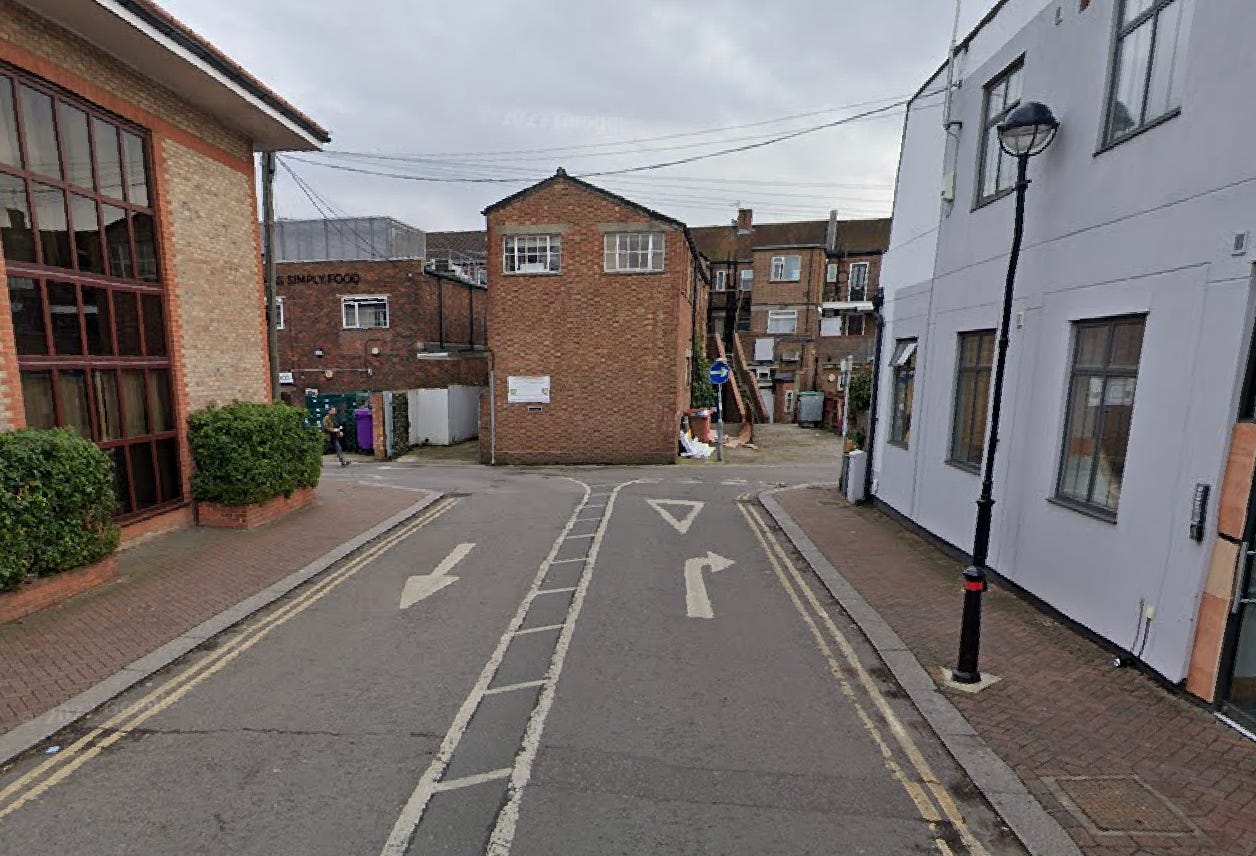Is the Savoy *Really* the Only Place you Must Drive on the Right?
And how did this come about?
Welcome to your Friday email for paying subscribers, with a generous preview for everyone else.
Paying subscribers… see the foot of this newsletter for details on our next historical site visit!
It’s half-term here in the UK, and I find myself up to my very ear lobes with children. I had started a brand new feature but, despite helming a time machine, the hours slip away from me.
So for this week’s instalment, I’ve got another excerpt from my book Everything you Know About London is Wrong. I say “excerpt”. As usual, I copied it over and then found myself going down various rabbit holes, adding, re-writing and supplementing, until the end result is rather different. But hey-ho. You can read it after the History Radar, which highlights upcoming events with a London flavour.
History Radar
⏲️🍳 SECRET LIFE OF THE HOME: The Science Museum’s much loved basement gallery of domestic appliances will close forever on Sunday (2 June), so this is your last chance to reminisce.
✍️📕 CITY SCRIBBLERS: On Tuesday 4 June, head to Guildhall Library (or watch online) for a talk about the “often eccentric contributions to literature and the life of the Square Mile” made by authors, from Chaucer to Mantel.
🏞️🚶🏾♀️SECRET SUBWAY: A rare chance to see inside the Crystal Palace Subway presents itself today, as part of the London Festival of Architecture. The ridiculously ornate underpass has been closed for decades, but occasionally opens for tours. This one’s free, but you need to prebook.
🏠🧒🏻 HISTORY HOUSE 140: Oxford House in Bethnal Green opens a new exhibition from 6 June, exploring its own 140-year history, as well as focusing on social change in the East End over that period. View previously unseen material from Oxford House’s archive, new short films and forgotten stories. Check also the venue’s events programme, which includes a weekend of talks, performances and workshops.
🍺📍DRINK MAPS: In the 19th century, temperance societies produced detailed maps showing pub locations. The intent was to appall, rather than advertise. Author Kris Butler is at Stanfords on 6 June to talk about her new book on the subject, including a map of London.
👸🏻📗 QUEEN'S READING ROOM FESTIVAL: Hampton Court Palace hosts the Queen's Reading Room Festival on 8 June, a literary event which combines music and history in rather flash surroundings. Miriam Margolyes, Helena Bonham Carter, Sir Ian Rankin and Harlan Coben are among the headliners this year.
💨🍞 UPMINSTER WINDMILL: The recently restored windmill at London’s easternmost fringe has its monthly open weekend on 8-9 June. You’re encouraged to book in advance to guarantee entry to this historic landmark.
Is the Savoy *Really* the Only Place in London Where you Must Drive on the Right?
The following is an edited and much embiggened extract from Everything you Know About London is Wrong.
The eye is easily drawn into Savoy Court, a small cul-de-sac off the Strand. The art deco entrance to the Savoy Hotel is one of London’s minor landmarks. If you let your gaze linger, you might spot something decidedly odd about the court. Cars are instructed to enter via the right-hand lane, contrary to normal UK traffic regulations. According to most sources, this unusual arrangement was established in an Act of Parliament in 1902 and, by this Act, Savoy Court is the only place in Britain where right-hand drive is permitted. I’ll get into the history of this curiosity in a few paragraphs’ time, but first let’s tackle its claim to uniqueness.
I don’t think it’s true. Other righty roads exist. Just hang around at a bus station. Bus doors are always on the left-hand side of a vehicle, for the simple reason that the driver’s cab must be on the right. This can have consequences at bus stations with island shelters. Sometimes, approach roads force the bus to the right-hand side, so that their doors are on the correct side for the bus stop. Hammersmith bus station is a good example. Instructions to “drive on right” are clearly marked on the tarmac by the entrance.
“OK, but that’s for buses only,” you will almost certainly retort. “Surely that’s not the same thing as Savoy Court.” True, true. But I can also find examples where cars and other private vehicles are required to drive on the right. The car park at Victoria station, for example, has a reversed layout. Look, I’m geeky enough that I even took my own photograph of this one:
The setup is potentially confusing for pedestrians crossing the entrance of the car park, who must remember to look for approaching vehicles in the non-intuitive direction. I almost fell for this myself, shortly after taking this photo.
Now you might say: “Yes, well, that’s fine, but again car parks are semi-private spaces, not proper public highway.” And I’d counter that the same could be claimed of Savoy Court, which is operated as a private road for the Savoy and its theatre. But can we find any examples of indisputably public highway with its directions all a-twist?
One now defunct example could be claimed in the notorious Tottenham Hale gyratory system. Until 2014, a short section known as The Hale featured a reversed-direction dual carriageway. Vehicles were separated by a central partition, but they nevertheless proceeded in the “wrong” direction. We can see this in a Streetview image from the time:
I’m happy to report (but also a little saddened) that the Tottenham Hale Gyratory has since been de-gyratorialised. This stretch of road now has conventional handedness.
Not so this minor road in Twickenham, which yet again is the entrance to a car park but certainly has the flavour of a public road:
Update 3 Jun 2024: Reader George tells me that UCL Hospital used to have a left/right swap-over on its rear entrance. You can see this in old streetview images. The lanes are separated by planters, but it still looks a little confusing. The set-up has now been converted to one-way.
Those are the ones I know about. I imagine there are other examples to be had, especially if we widened the search beyond London. Each one has an element of “does that really count?” about it, but then so too does the Savoy. Anyhow, this is a history-focussed newsletter, so we should probably return to the history.









